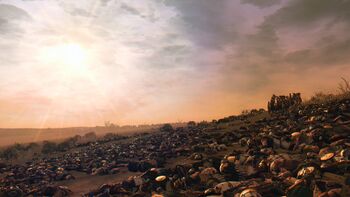Battle of the Ghalenna River
| Battle of the Ghalenna River | |||||||
|---|---|---|---|---|---|---|---|
| Part of the Makedonian-Hannashka Wars | |||||||
 Makedonian soldiers among the dead. | |||||||
| |||||||
| Belligerents | |||||||
|
|
| ||||||
| Commanders and leaders | |||||||
|
|
| ||||||
| Strength | |||||||
| 250,000-300,000 (Thespis) | 275,000 (Thespis) | ||||||
| Casualties and losses | |||||||
| 150,000 (Thespis) | 120,000 (Thespis) | ||||||
The Battle of the Ghalenna River was fought between the Makedonian Empire and the Hannashka Empire from 16-18 June 268 during the Makedonian-Hannashka Wars. A Makedonian army under General Rhaekos attempted to cross the Galen River and defeat a Hannashka Army led by Kamadyu the Magnificent. After an exceptionally bloody two days of fighting, the Hannashka ceded the river to the Makedonians, though the Makedonians would be forced to withdraw back across the Galen shortly afterwards.
Background
The Makedonian-Hannashka Wars had first erupted in 151 CE and was marked by border skirmishes and clashes until the Third Century which saw Makedonian gains into regions typically loyal to the Hannashka, including the region of Khaltia. By 250 CE Makedonian influence had spread into present-day Ganjarejan, with raids as far south as Jalandhar. Fears that the Hannashka would be forced to surrender to Makedon were alleviated with the ascension of Kamadyu to the throne in 257, who immediately began planning for a reconquest of Khaltia. By 265 Kamadyu had pushed the Makedonians out of Ganjarejan and had launched incursions into Mansuriyyah, but encountered heavy resistance by the Makedonian armies led by Rhoekos of Sena. In the spring of 268 Rhoekos launched an offensive to drive the Hannashka out of present-day Mavarnahar, leading Kamadyu to muster her forces east of the Galen River to check the Makedonian advance. The two sides clashed in a number of skirmishes prior to the meeting of the full extent of their armies on 16 June.
Forces involved
Both armies reflected the diverse range of their respective empires and the wide array of peoples and tribes under their domain. The Hannashka fielded an army heavily based on cavalry of all types with supporting infantry, archers, and war elephants. This included Hannashka, Erani, and Khaltian heavy and light cavalry, horse archers, and cataphracts, Tennaiite and Erani longbows, Khaltian infantry both light and heavy, Kohrka infnatry, Tennaiite mercenaries, and Nalayan levies. The Makedonian army was centered around its pike wielding infantry arrayed in a phalanx formation, the most well drilled infantry of their day. Supporting the phalanx were heavy infantry from Ruvelka on each flank, with additional Hayren infantry and light infantry from the Mansuri satrapies of Qatna, Kanesh, and Irviym. Makedonian cavalry consisted of heavy lancers from Galania, and horse archers from Arkoenn. Melee cavalry from the Khiyzan were also employed, as well as Bosrei mercenaries. Scitarian levies also served as skirmishers and light infantry with Chrysian archers also employed. Some artillery pieces like catapults, ballisteas, and onagers produced by Han siege engineers captured from Serkios were also featured in the Makedonian army.
As was common, the Hannashka held superiority in cavalry while the Makedonians held greater infantry. The primary sources for the troops and the size of the armies is Thespis, a Syaran historian who accompanied Rhoekos on his campaigns. Thespis's reliability as a historian is mixed; as a former officer in the Makedonian army Thespis is considered a reliable source when it comes to the reporting of troop types, their roles, and the maneuvers taken during battle, but he is also known to have frequently exaggerated the numbers and casualties involved in battle. Most historians reject his proposed numbers for the Makedonians and Hannashka at Ghalenna, which he put at 275,000 and 300,000 respectively. Nevertheless modern historians conclude both sizes fielded a considerably large amount of troops, though it is impossible to determine an exact number.
Battle
The Ghalenna river flows in a south-west direction across Khaltia, ending in Galighan.